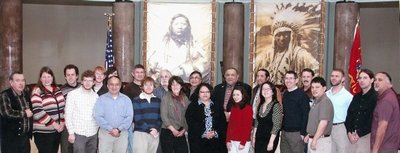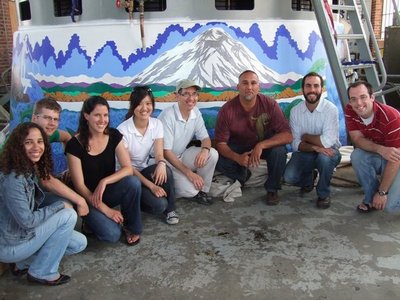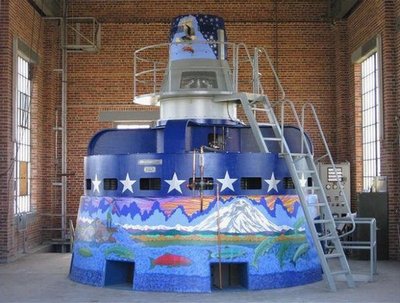May 27, 2010
UW, tribal partnership to develop Pacific Northwest bioenergy
Biofuels are increasingly popular, but also controversial. Ethanol from food crops has been criticized for raising food prices or displacing forests. In some cases, biofuel feedstocks must be transported many miles from where they are grown to where they are used, burning energy along the way.
For the past two and a half years researchers at the UW have been working with local Native American tribes on a different approach. They are developing locally produced bioenergy that makes sense for the Pacific Northwest.
The UW’s program on Bioresource-based Energy for Sustainable Societies is training teams of graduate students to research potential bioenergy projects tailored to Northwest tribal lands. At this month’s Tribal Leadership Summit they presented a bioenergy plan they developed with the Yakama Nation.
It’s a natural fit for Native American tribes to be leading the way in bioenergy, said program director Dan Schwartz, a UW professor of chemical engineering.
“The tribes are in a unique position to become leaders in developing projects that meet the triple bottom line: economic, ecological and social outcomes,” Schwartz said. “The tribes have sovereignty over their land, and they consider multiple objectives beyond simply economics in their decision-making.”
“The green economy fits well with our community and our goals,” said Phil Rigdon, deputy director of the Yakama Nation’s Department of Natural Resources and an early partner on the bioenergy program. “I think it is our future.”
The UW, for its part, provides technical expertise and students who want to learn about putting clean and renewable energy research into practice.
One such student is Tim Geary, a chemical engineer who hopes his experience will help him in a career in a national energy lab or a clean-tech startup.
“As an engineer you say, ‘We’re going to use wheat straw as a feedstock,’ but you have no idea where that feedstock comes from,” Geary said. The UW’s bioenergy program teaches students to consider: “How feasible is this? What is the policy that’s stopping it? What are the environmental and social boundaries?”
Sustainable biofuels for the Yakama Nation
Students in the Bioresource-based Energy for Sustainable Societies program, more than a quarter of whom are tribal members, spend two years working to address a specific need identified by the tribal partner. The first group of eight students began in 2007 and worked with the Yakama Nation to develop bioenergy projects in southern Washington.
The Yakama formed an electrical utility, Yakama Power, in 2000, and wants to expand its hydroelectric operations to include other renewable sources. The tribe also owns Yakama Forest Products, which currently buys more than half of the utility’s electricity to operate two sawmills. Now, with the UW program’s help, it hopes to use sawmill waste and other woody debris to power the very machines that generate the sawdust.
Another important source of feedstock is non-native plant matter. Russian olive is an invasive tree species that is widespread on Yakama lands and choking out native plants. One way to get rid of the trees is to cut, pile, and burn them, but that costs money, and the smoke pollutes the air.
The tribe asked the UW to look at the feasibility of using these waste wood products to generate energy.
Students working with Monika Moskal, a UW assistant professor of forest resources, used satellite maps to identify the location of biomass. They then established where the roads are, and how much it would cost to move this plant material to an optimal central location.
A student of John Perez-Garcia, a UW professor of forest resources, helped predict how much biomass will be there in the future, to determine whether building a boiler would be worth the financial investment.
“It’s about getting more independence for the tribes, I think that’s what it ultimately comes down to,” said Steve Rigdon, generation manager at Yakama Power who last year also enrolled in the UW bioenergy program as a student.
The tribe will need a conventional wood boiler to generate electricity and heat or a chemical reactor to convert the wood into something else, such as a liquid fuel. Ultimately, the hope is that the power production will help offset the cost of eradicating invasive species and cleaning up forestry debris to minimize wildfires.
“Typically there’s a tension between restoration ecology and bioenergy,” said Tom Hinckley, a UW professor of forest resources. “This project shows we can get a win-win.”
Tribal renewable energy workshop
Members of the UW bioenergy program are reaching beyond Washington state to advance sustainable renewable-energy projects. This month the UW hosted its first Tribal Renewable Energy Research workshop in the days leading up to the Tribal Leadership Summit. More than 80 participants attended from universities, tribes, utility companies, private industry and governmental organizations.
The workshop was the idea of Laurel James, a UW student in the bioenergy program who organized the workshop and got funding through the National Science Foundation.
“There are commonalities between all the tribes in terms of the barriers to implementing renewable energy projects,” said James, who worked for 17 years in the Yakama Nation wildlife program before enrolling in the UW bioenergy program. “We want to be able to share how other tribes are overcoming these barriers.”
Sessions explored shared tribal and academic interests, and provided information on the tribal green economy.
“In today’s world we have new markets,” said Jonny BearCub Stiffarm, a business development officer at Native Energy. The company sells renewable energy credits and carbon offsets to individuals, Hollywood celebrities, and corporate clients such as Aveda, Ben & Jerry’s and Stonyfield Farms. Tribal projects are in high demand, Stiffarm said, and encouraged workshop participants to contact her.
Closer to home, a representative of the Tulalip Tribe described its nonprofit partnership working with local dairy farmers to produce bioenergy by capturing the methane from decomposing cow manure and then burning it to produce energy. The Qualco Energy plant now generates 450 kilowatts of energy, which Puget Sound Energy buys as part of its Green Power Program.
Sandra Begay-Campbell, with the U.S. Department of Energy’s Tribal Energy Program, provided a national overview of projects such as solar-powered refrigerators on the Navajo Nation and the Rosebud Sioux Tribe’s wind turbines.
Brian Polagye, a UW research assistant professor of mechanical engineering, co-presented a session looking at the potential for using wave or tidal generators, now under development at the Northwest National Marine Renewable Energy Center, on tribal lands.
In the summary session, Don Motanic of the Intertribal Timber Council said that in his 25 years working in this field: “This is really the first time that the tribes have stepped forward and said: ‘This is our research agenda.'”
Organizer James is writing a summary of the event.
“Many of the speakers have told me that they’ve attended workshops on renewable energy, but this one was different in the unique way we combined tribes, research and academics,” she said. “We hope to create a document that will help tribes in Washington state and across the country.”
In addition, a student in the UW Department of Communication’s Native Voices program filmed the proceedings and plans to make a video of the event.
Interdisciplinary graduate education
The bioenergy program is funded through the National Science Foundation’s Integrative Graduate Education and Research Traineeship. The national IGERT program was established in 1997 as a new model for graduate science education that incorporates different academic disciplines. The IGERT program also has a mandate to encourage diversity among its students.
The UW is one of the nation’s leading IGERT campuses, with active programs in in nanotechnology, global environmental studies and astrobiology.
The bioenergy-focused IGERT launched in 2007 with a $3 million grant from the National Science Foundation.
The second group of bioenergy students, who began in 2008, are working with the Confederated Salish and Kootenai Tribes in northwestern Montana. UW students have begun preparing an inventory of the tribe’s wind and solar generation capacity, and are also going to look at agricultural and forestry waste.
Two students from Salish Kootenai College have joined the most recent group of students, who will work with a tribal partner that is still being established.
Bioenergy program’s funding renewal is currently under review. Students and faculty in the program hope that it will continue further.
“We don’t want the program to stop,” Rigdon said. “There are a lot of other tribes and a lot of other needs.”





